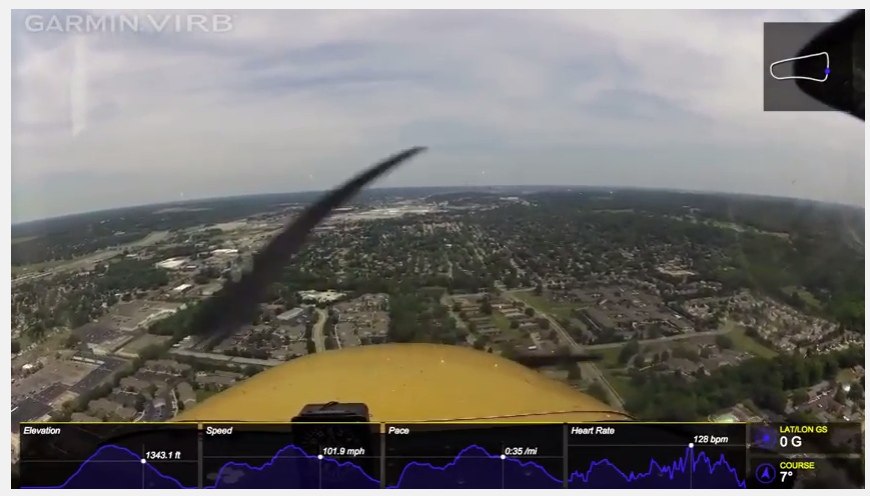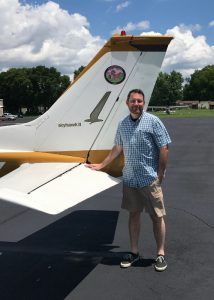
Human Performance Scientist and pilot-in-training Dr. Ronald Storm barely remembers the first time he took off in a plane during a flying lesson six months ago. But he vividly remembers sitting in a cockpit with his father more than 40 years ago when he was just 4 years old. “My first memories are of airplanes,” said Storm, 45. “My dad flew DC-3s and I remember sitting in the cockpit. We have a Polaroid of it.”
Storm, who holds a doctorate in business administration from Argosy University in Tampa and is an expert in individual and group decision making, has an explanation of why his first aviation memories are so vivid while his recent memories of flight lessons are so vague.
“When mental load increases, our awareness gets narrow,” Storm explained. “Cognitive load” or “mental load” refers to the total amount of mental effort being used in the working memory. Flight demands focus from pilots, and novice pilots who have not yet fully developed their skills are forced to make a larger mental effort than experienced pilots to accomplish the same tasks. This larger mental burden can prevent new pilots from picking up finer details about their experience.
When pilots in training become more comfortable in the cockpit, they have improved situational awareness. Storm’s theory is that the more student pilots train with a simulator, the more comfortable they will feel during the lesson in actual flight, and that comfort will translate into a deeper learning experience. Now Storm is trying to prove his theory by first collecting heart rate data on himself as he navigates the Gleim Aviation X-Plane Flight Training Course. Eventually he will expand his data collection to other pilots in training.
Biometrics and Data Collection
Storm decided to first conduct the study on himself by measuring his own heart rate variability (HRV) as a predictor of both physiological and cognitive success. He used this method before when researching data science methodologies to select and train both dismounted elite athletes (football) and mounted uses (motor sports and aviation).
Biometrics is the measurement and statistical analysis of human physical and behavioral characteristics. The technology is primarily used for identification and access control or for identifying individuals that are under surveillance, but Storm believes the technology can be applied to identifying when students learn.
While most scientists avoid using themselves in experiments, Storm believes beginning by conducting the research on himself has its advantages. “I am measuring my physiology with in-flight training and while using a simulator,” he said. “As a social scientist, I am able to see the differences in myself that I know should happen, where a student can’t articulate why it’s better, and when it should be better.”
To measure his HRV, Storm wears a heart rate monitor while he flies. He modeled his data collection on previous experiments he conducted while monitoring heart and response rates of professional athletes in training. “I am measuring myself over many, many events,” Storm said. “When you get 20 or 30 measurements, you start to see patterns.”
“How does it change every lesson over time? If my heart rate is 60 when I start flying and 120 when I’m in the air, that’s a 60 beat difference.”
Storm’s primary focus is his heart rate’s rate of change, he said. According to his theory, as a pilot in training gains experience, his or her heart rate changes while becoming relaxed, confident, and comfortable flying.
Learning to Fly
Storm recently quit his day job and founded GCI, Inc., a strategy, program management, and engineering company that serves clients, such as the Department of Defense and commercial customers, in the area of “Blue Sky” concepts. Now that it is established and finding success, Storm finally has the time to turn toward personal interests. “I started a company, and now I have time to fly and get a license,” Storm said. “It’s one of my goals in life.”
“In Aviation, I had been building interfaces, but never flew a plane as the Pilot in Command,” said Storm, who has been working in the manned and unmanned aviation community for the past 10 years. “Learning to fly is a way to improve my craft.”
Early Indicators
Only eight hours into his flying lessons, Storm can already see that his data collection is worth interpreting. “Can I detect when I am cognitively overloaded?” he asked. “Yes, by looking at the graph. Can I tell I am getting better looking at the data? Not yet,” Storm added. “But I physically feel better when I fly now.
“Does using Gleim make me a better pilot? The more I train with the simulator the more comfortable I feel during the lesson,” Storm said. “I feel confident. I went through the steps, approach pattern, slow turn, cluster six pack in front of me. Relearning that doesn’t or re-acclimation doesn’t have to take place. I can measure the effect of experience.”
Gleim Aviation Marketing Specialist and Flight Instructor Paul Duty said Dr. Storm’s data collection and analysis provides validation that the Gleim X-Plane Flight Training Course translates to becoming a safer pilot. Duty, who has been a flight simulator enthusiast for over 20 years, combined at-home, computer-based flight simulation with his training when he learned to fly and become an instructor over 15 years ago. Duty said that future pilots can learn faster and retain more knowledge, especially when simulation has a structured approach like what is provided in the Gleim X-Plane Flight Training Course.
“Our goal is to help student pilots earn their pilot certificates in less time, and for less money, while becoming safer pilots,” Duty said. “This research will correlate the simulator training we developed to the real world training environment. This will prove that using a structured flight simulation approach for VFR training is a valuable resource for primary students, just as simulators are already prevalent for IFR training.”

While the Garmin Virb presets measurements to include Elevation, Speed and Pace, it’s the Heart Rate measurements that Storm is using to measure his anticipation, nervousness and task overload as he takes off, maneuvers and lands. Storm says he sees a trend in his readings from this flight in a Cessna 172M. “My heart rate is decreasing in different parts of flights,” Storm said. “It started in 120-130 BPM in all phases and continues to drop into the 80s and 90s most of the flight. Storm is using Gleim Aviation’s X-Plane software to practice flight simulation and hopes to prove the more simulation time he logs, the better pilot he becomes.
Future implications

In the first round of data collection, Storm is using a single-screen simulator to conduct his study. In upcoming rounds of data collection, Storm will be practicing techniques and maneuvers on the Gleim Virtual Cockpit, which offers a home simulator platform, configured to match a typical training airplane cockpit with displays across three screens for panoramic visibility. For Storm, the more realistic the simulator, the better prepared he’ll be for new techniques in actual flight.
As he expands his study and collects data on other pilots in training, Storm said the statistics will be valuable for students and instructors.
Biometrics will be a valuable indicator for student performance and mental load. “Some students are not ready and want to be,” Storm said. An instructor can quantify and show the student that they aren’t ready by revealing the results of their biometrics. Conversely, “an instructor can encourage self doubters,” Storm added. When a student doesn’t think they are accomplishing or learning lessons, the data can show the improvements they have made and alleviate common frustrations.
As Storm prepares to learn landings in an upcoming lesson, he is anxious to join the ranks of his family members who are accomplished pilots. “I come from a huge aviation family,” said Storm who said he rebelled as a teen and joined the U.S. Navy to operate submarines. “My mother got her pilot license in 1952 at age 16 and she owned a Ercoupe,” he said. “My dad was a pilot. Our last big thing we did together was attend the Detroit Red Bull Air Race.”
For more information about the Gleim X-plane Flight Training Course, visit GleimAviation.com/simulation.
About Gleim Aviation
Since 1980, Gleim Aviation’s team of pilots, instructors, writers, designers, and programmers has helped aviators pass millions of FAA knowledge and practical tests using the unique Gleim Knowledge Transfer System. Gleim is an environmentally friendly company headquartered in Gainesville, FL. Learn more at www.GleimAviation.com or call (800) 874-5346 ext. 471.

